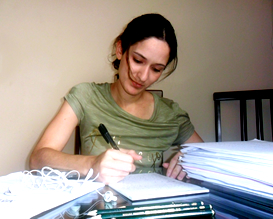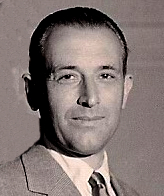|
|
|
| The Importance of Shorthand Reading Practice. |
|
A PRÁTICA DA LEITURA TAQUIGRÁFICA.
Importante na formação de um taquígrafo é o exercício sistemático de leitura do que acabou de ser taquigrafado. A leitura ajuda muito na memorização e no aperfeiçoamento dos sinais taquigráficos.
_______________________________
O hábito da leitura taquigráfica deve começar desde as primeiras lições e - principalmente - quando o aluno começa o treinamento dos ditados progressivos de velocidade.
________________________________
O ideal é ler normalmente, como na grafia comum, ou seja, ler o conjunto, o todo, prestando atenção no assunto, e não ler palavra por palavra.
|
TEXTO: A Importância da Tradução.
 |
TEXT: The Importance of Translation.
|
|
Cláudia Moreira - Método Maron - Ex-aluna presencial do prof. Waldir Cury.
Maron System - Cláudia studied shorthand with Mr. Cury.
|

|
Taquigrafando na velocidade de 100ppm.
Taking down a dictation at the speed of 100wpm.

|
Lendo.
Reading.

|
Ana Rocha - Método Maron - Ex-aluna presencial do prof. Waldir Cury.
Maron System - Ana studied shorthand with Mr. Cury.
|

|
Taquigrafando na velocidade de 80ppm.
Taking down a dictation at the speed of 80wpm.

|
Lendo.
Reading.
 |
Taquigrafando na velocidade de 90ppm.
Taking down a dictation at the speed of 90wpm.

|
Lendo.
Reading.

|
Taquigrafando na velocidade de 100ppm.
Taking down a dictation at the speed of 100wpm.

|
Lendo.
Reading.

|
Alexandre Reis - Método Maron - Ex-aluno do Curso de Taquigrafia Online. Atualmente, taquígrafo do Tribunal de Justiça do Estado de Minas Gerais.
Maron System - Alexandre is a self-taught shorthand student. He has learned shorthand by means of the online course of Mr. Cury.
|

|
Taquigrafando na velocidade de 120ppm.
Taking down a dictation at the speed of 120wpm.

|
Lendo.
Reading.
 |
Erica Ennes- Método Maron - Ex-aluna presencial, primeiro, da professora Deborah, depois, do prof. Waldir Cury.
Maron System - Erica studied shorthand first with Miss Deborah, and then with Mr. Cury.
|

|
Lendo um texto taquigrafado.
Reading a shorthand text.

|
Roberta Moraes - Método Maron.
Aprendeu o método com a professora Márcia Beatriz Horta Britto.
Treinou velocidade com a professora Deborah Botelho, até a velocidade de 60ppm. Prosseguiu o treinamento autodidaticamente, valendo-se dos ditados do site "taquigrafia.emfoco".
Maron System - Roberta studied shorthand with Miss Márcia Beatriz Horta Britto. Then, she had speed classes with Miss Deborah Botelho until she was able to take dictations at 60wpm. Then, she proceeded by herself, making use of the dictations available at this shorthand website.
|
 |
Taquigrafando na velocidade de 80ppm:
Taking down a dictation at the speed of 80wpm.
http://www.youtube.com/watch?v=lxORdEIY8JY
|
Lendo:
Reading.
http://www.youtube.com/watch?v=MtLpu1CXheA
|
Isabela Cançado - Método Maron (Aluna do Curso de Taquigrafia Online.)
Maron System - Isabela is studying shorthand by means of the online course of Mr. Cury.
|

|
Taquigrafando na velocidade de 80ppm.
Taking down a dictation at the speed of 80wpm.

|
Lendo.
Reading.

|
Aline Pio- Método Maron - (Aluna do Curso de Taquigrafia Online.)
Maron System - Ana studied shorthand by means of the Online Course of Mr. Cury.
|

|
Taquigrafando na velocidade de 50ppm.
Taking down a dictation at the speed of 50wpm.

|
Lendo.
Reading.
 |
Taquigrafando na velocidade de 45ppm.
Taking down a dictation at the speed of 45wpm.

|
Lendo.
Reading.

|
Taquigrafando na velocidade de 30ppm.
Taking down a dictation at the speed of 30wpm.

|
Lendo.
Reading.

|
TRECHOS DE ARTIGOS E LIVROS SOBRE O TEMA
"LEITURA TAQUIGRÁFICA"
 |
| Do livro: "Shorthand Teaching Technique", de B.W. Canning |
A habilidade em traduzir os sinais taquigrafados é tão essencial quanto a habilidade em taquigrafá-los.
(The ability to read shorthand is clearly just as essential as the ability to write it.)
|
Ler em voz alta um texto taquigrafado corretamente é uma boa aprendizagem, porque entram em funcionamento dois sentidos, a visão e a audição, um reforçando o outro.
(Good reading aloud of correct shorthand is good learning because it operates by the use of two senses, sight and hearing, each reinforcing the other.)
|
- Não há dúvida de que o ideal é que o aluno leia tudo que for taquigrafado num ditado.
(Ideally there is no doubt that everything dictated to be written in shorthand should be read back.)
|
- Qualquer que seja a técnica adotada para se obter uma leitura corrente, temos sempre que voltar a bater na mesma tecla, ou seja, na necessidade de cada aluno em particular ser treinado até chegar no nível de leitura instantânea e completa do trecho taquigrafado inteiro.
- (Whatever techniques are adopted for fast and interestingly varied reading back, we have always to come back in the last resort to the necessity for each individual student to be trained to the level of instantaneous and complete reading back of a whole note.)
|
- Uma prática constante de leitura taquigráfica, além de propiciar um enriquecimento no vocabulário, aumentará a familiaridade com o traçado taquigráfico, desenvolvendo, conseqüentemente, o automatismo em taquigrafar e em ler, o que é, em última análise, o nosso objetivo.
- (Abundant reading practice will build up an extensive vocabulary. Increasing familiarity with outlines will build the automaticity in writing and reading that it is our aim to create.)
|
- Os alunos devem ter sempre a oportunidade de conferir suas notas taquigráficas em silêncio, acrescentando uma vogal aqui, um fonema ali, verificando um ponto final, taquigrafando de novo um traçado malfeito, analisando as notas taquigráficas em busca de erros no traçado e trechos mais deficientes.
- (The students should always have the chance to check through their own note in silence, adding a vowel or a diphone, verifying a full stop, rewriting a malformed outline, scanning the note for penmanship weaknesses, and attacking the note at what they will know is its weakest spot.)
|
- Não é suficiente um aluno trabalhar simplesmente um trecho e ficar contente com uma única leitura. O valor de uma segunda e uma terceira leitura, em velocidades crescentes, é maior do que o valor de uma única leitura. Quanto mais longe pudermos ir na estrada do "aprendizado intenso, repetitivo", maiores os dividendos, que resultarão na exatidão e automatismo ao taquigrafar um ditado.
- (It is not enough for the student merely to work through the passage and be content with a single reading. The value of a second and third reading at increased speeds is even greater than the value of a single reading. The farther we can go along the road of "over-learning" the greater the dividends that will accrue in accuracy and automaticity of writing from dictation.)
|
Com toda certeza há uma ligação muito grande entre o modo como se taquigrafa e a habilidade para se ler os sinais taquigráficos. As fraquezas comuns já foram especificadas atrás, mas vale a pena repeti-las:
(a) Pressão indevida. Nove de dez alunos não taquigrafam com a leveza necessária.
(b) Traçados taquigráficos defeituosos. Distorção do sinal, comumente resultante da pressa e da falta de um treinamento específico para controle manual.
(c) Sinais taquigráficos incorretos.
(d) Falta de uniformidade no tamanho.
(e) Erros na posição dos sinais.
(f) Sinais muito grandes, gerando inclusive perda de tempo.
(g) Lentidão no traçado dos sinais. Uma deficiência no uso do estilo cursivo, fluente e controlado, essencial para a velocidade taquigráfica.
- (Clearly there is a very close link here between penmanship and note-reading ability. The common weaknesses have previously been referred to, but they will bear repetition: (a) Undue pressure. Nine out of ten students do not write lightly enough. (b) Malformed outlines. Distortion of shape commonly results from haste and from lack of guided training in manual control. (c) Inaccurate outlines. (d) Lack of uniformity in size. (e) Faults in positioning. (f) Outlines too large and sprawling, and therefore timewasting. (g)Slowness of execution. A failure to use the correct cursive, fluent, and controlled "flicking" style, essential at speed.)
|
- O aluno deve ser ensinado a tirar proveito da autocrítica. Cada sinal taquigráfico que é lido errado ou que causa hesitação deve ser taquigrafado de modo correto na margem.
- (The student must be taught to benefit from self-criticism. Every outline that is misread or causes hesitation must be correctly written in the margin.)
|
Do livro: THE METHODS OF TEACHING SHORTHAND – A PRACTICAL TREATISE ON THE SOLUTIONS OF CLASSROOM PROBLEMS.
BY Edward J. Mcnamara, M.A. |
Nenhum esquema para desenvolver a velocidade taquigráfica será completo se não utilizar o recurso da leitura daquilo que foi taquigrafado.
No plan of developing speed in shorthand is complete unless it utilizes the power to be obtained from the Reading of shorthand notes.
|
A transcrição correta das anotações taquigráficas é a etapa final do taquígrafo, através da qual seu trabalho poderá ser avaliado. Por esta razão, tudo que for taquigrafado deve ser lido. A mera suposição de que pode ser lido não tem valor algum. O que tem valor mesmo é a leitura efetiva do texto taquigrafado, não importam quantas vezes a leitura for repetida.
The correct transcription of the notes is the final act of the speed writer that gives the work value. For this reason everything that is written should be read; the supposition that it can be read is of no value, but the actual reading of it has a distinct value no matter how many times the reading is repeated.
|
O maior benefício gerado por tal leitura é o conhecimento que o estudante adquire dos seus erros crônicos ao taquigrafar. Sob a pressão da velocidade, é provável ocorrerem distorções dos sinais, e quanto mais o texto taquigrafado é lido, mais familiaridade se adquire em relação a essas distorções, aumentando-se, então, a habilidade de lê-las prontamente, na medida em que são levadas em consideração as distorções que são prováveis de acontecer.
The greatest benefit to be derived from such reading is the knowledge which the student obtains of his chronic errors of writing. Under the pressure of speed distortion of notes is always likely to occur, and the more the notes are read, the greater the familiarity is obtained with these distortions and the ability to read them readily by making allowance for a distortion that is likely to occur is acquired.
|
Ao se planejar uma aula de velocidade, devem ser levados em consideração os seguintes tópicos:
Hábitos corretos de escrever,
Um conhecimento completo do método,
Aplicação instantânea dos princípios que regem a elaboração dos sinais,
A capacidade de taquigrafar as palavras,
Vocabulário na grafia comum e na taquigrafia,
A prática da repetição
O uso de um novo assunto,
E a prática da leitura.
Quando o esquema é organizado, levando-se em consideração os itens acima, o sucesso já está a meio caminho.
In planning the instruction of a speed class account should be taken of all these essentials:
correct habits of writing,
a thorough knowledge of the system,
ready application of word-building principles,
the word-carrying capacity,
vocabulary in longhand and shorthand,
repetition practice,
use of new matter,
and reading practice.
When the instruction is planned with these things in view success is more than half attained.
|
Do Artigo:
IN SHORTHAND REPORTING, READING ABILITY MUST MATCH WRITING SKILL
Charles Lee Swem, Official Reporter, New York Supreme Court.

Taquígrafo oficial do Presidente dos Estados Unidos, o Sr. Swem taquigrafou todos os discursos do Presidente Wilson e discussões na grande Conferência de Paz.
|
Se a velocidade é o fator mais importante no registro taquigráfico, a habilidade de ler não é menos relevante. Muitos até colocam a leitura taquigráfica antes da velocidade, alegando que toda a velocidade do mundo seria inútil, se aquilo que se taquigrafou não puder ser lido posteriormente.
If speed is the most important factor of reporting, the ability to read must come not very far after. There are many who would place reading ability first, ahead of speed, arguing that all the speed in the world is useless if the notes cannot be read afterward.
|
A habilidade de ler as anotações taquigráficas é, em muitos aspectos, totalmente distinta da habilidade de taquigrafar.
The ability to read shorthand is in many respects a distinct art of itself, wholly apart from writing.
|
O conhecimento profundo do método é essencial, como essenciais são também a familiaridade com o próprio estilo e a prática da leitura taquigráfica; a memória ajuda, mas aquela habilidade sutil em ler a escrita taquigráfica tão fluentemente como costuma ser lida pelo taquígrafo profissional competente, é o produto de algo além e acima desses fatores mencionados.
Algumas vezes, fico convencido de que esse algo mais é a imaginação, a capacidade de pensar com precisão.
Perfect knowledge of system is a prime essential, also familiarity with one’s style and much practice in reading; even memory will help, but that fine ability to read shorthand outlines as fluently as they are read by the competent reporter must be the product of something over and above these things.
Sometimes I am convinced that that something else is imagination, the ability to guess accurately.
|
Todos os excepcionalmente bons leitores de taquigrafia são invariavelmente pessoas de imaginações ativas, pessoas que são capazes de “preencher as lacunas”, não apenas no texto taquigrafado, mas em todas as coisas que empreendem. A taquigrafia é, afinal de contas, uma mera escrita de sinais. Os sinais que escrevemos para representar uma palavra ou uma frase inteira não passam de uma mera representação de uma palavra inteira ou uma frase. Dessa representação, a mente deve fornecer uma imagem da palavra inteira, preenchendo a forma, o conjunto e as nuances, onde forem necessários.
All the exceptionally good readers of shorthand are invariably people of active imaginations, people who can “fill in the gaps” in shorthand not only, but in whatever they undertake. Shorthand, after all, is mere “outline” writing. The outline that we write to represent a word or a phrase is a mere suggestion of the complete word or phrase. From the suggestion the mind must supply the picture of the whole word, filling in the form, the body, and the colors where necessary.
|
A leitura taquigráfica se dá através da aferição contínua de possibilidades, de comparação de um elemento com outro elemento, de um verbo com um substantivo, de uma vogal com uma consoante, até chegar-se à última probabilidade do que o orador quis dizer, antes da caneta (do taquígrafo) deslizar pelo papel.
Aqueles imaginativos detetives de ficção, que conseguem desvendar brilhantemente crimes de difícil solução, não mostram sequer a metade do poder analítico que a média dos taquígrafos profissionais conseguem mostrar ao ler uma dúzia de páginas taquigrafadas com rapidez.
The reading of shorthand is a continuous measuring and gauging of possibilities, of offsetting factor against factor, verb against noun, vowel against consonant, and arriving at the ultimate probability of what was intended before the pen slipped or the mind wandered. Those mythical detectives of fiction, who arrive at the most brilliant solutions of abstruse crimes, display not half the analytical power that the average shorthand reporter does in reading a dozen pages of hastily written notes.
|
Um conhecimento amplo da gramática e da sintaxe inglesa é fator indispensável para uma boa leitura taquigráfica. Sendo a taquigrafia o que é, ou seja, uma escrita por meio de sinais representando palavras, torna-se necessário conhecer a construção das palavras e dos seus equivalentes taquigráficos.
Necessarily, a thorough working knowledge of English grammar and syntax is an indispensable aid to good reading ability. Shorthand being what it is, an outline writing of words, it is as necessary to know something concerning the construction of the words themselves as it is to know their shorthand equivalent.
|
O taquígrafo tem apenas de estudar o seu método com um olho neste aspecto, para compreender quão necessário é o conhecimento da gramática e sintaxe inglesa, para o domínio verdadeiro da taquigrafia, mas, especialmente, para a leitura dos sinais taquigráficos.
The writer has only to study his system with an eye to this aspect of it to realize how basic a knowledge of English grammar and syntax is to a true mastery of shorthand, but especially to the reading of it.
|
A prática da leitura taquigráfica, da mesma forma que acontece em qualquer habilidade, resultará em certo grau de facilidade, mas há muito mais que aperfeiçoar do que apenas isso. O taquígrafo deve proceder a um estudo íntimo do seu próprio estilo e mapear seus próprios erros e sinais deturpados, do mesmo modo que o marinheiro leva em consideração as possíveis variações da agulha magnética da bússola. Ele deve conhecer as bases gramaticais do seu método. E, caso não possua o dom da imaginação, ele deve aprender a aproximar-se dela, pelo desenvolvimento de uma mente alerta e inquiridora. Tudo isso, a par de um conhecimento profundo do método, torná-lo-á alvo da inveja de outros taquígrafos – pois todos reconhecerão nele o leitor perfeito e fluente das notas taquigráficas.
Practice in reading outlines, as practice will do in any skill, will unquestionably make for a certain degree of facility, but there is much more to perfection than that. He must make an intimate study of his own style and chart his own personal deviations and declinations, much as the mariner allows for the variations of the magnetic compass; he must know something of the grammatical basis of his system; and if he does not possess the gift of imagination, he must learn to approximate it by the development of an alert and inquiring mind, which is the next best thing. These, and a thorough knowledge of system, if persisted in, will make of him the envy of all shorthand writers – the perfect, fluent reader of shorthand notes.
|
Do artigo: INDICACIONES Y CONSEJOS ACERCA DE LA MEJOR MANERA DE REALIZAR PRACTICAS TAQUIGRAFICAS.
POR: Avenir Rosell i Figueras.
(Sabadell, 1907 - Montevideo, Uruguais, 1988.)

Foi professor de taquigrafia e taquígrafo do Parlamento uruguaio. |
A PRÁTICA DA TRADUÇÃO
Deve-se alternar a prática da escrita com a da leitura, até para não cansar-se ou entediar-se.
O complemento obrigatório da escrita taquigráfica, que constitui 80% da utilidade da taquigrafia, é a leitura ou tradução. Deverá ser, portanto, também a segunda parte imprescindível de toda a prática.
Leia-se sempre o que for escrito taquigraficamente. Mais que a simples leitura, é preferível a tradução, ou seja: trasladar a escrita taquigráfica para a escrita comum, e melhor ainda que essa tradução se faça diretamente a máquina; desta forma, o aprendiz vai-se adestrando em aplicar e aproveitar a taquigrafia de acordo com o que será exigido no exercício da profissão.
A leitura pode também ser feita com escritos taquigráficos velhos, taquigrafados há três meses. A leitura dos exercícios feitos durante o estudo da teoria taquigráfica pode servir de revisão a esta, dando, desta forma, ao estudante, a oportunidade para corrigir algum erro teórico que possa ter cometido.
PRACTICA DE TRADUCCION
Débese alternar la práctica de escritura com la de lectura, hasta para no cansarse o aburrirse.
El complemento obligado de la escritura taquigráfica, lo que constituye el 80% de la utilidade de la Taquigrafia es la lectura o traducción; há de ser, pues, también la segunda parte infaltable de toda práctica.
Léase siempre lo que se haya escrito taquigraficamente. Más que la lectura es preferible la traducción, es decir: trasladar a caracteres comunes lo escrito em taquigrafia, e inmejorable que esa traducción se haga diretamente a máquina; em esta forma se va adiestrando el practicante a aplicar y aprovechar la taquigrafia según se le requerirá em el ejercicio de la profesión.
La lectura puede también efectuar-se com escritos taquigráficos viejos, escritos desde três meses anteriormente. La lectura de los ejercicios hechos durante el estúdio de la teoria taquigráfica, puede servir de repaso de ésta, teniendo así oportunidade el estudiante para corregir algún error teórico que pudiera haberse cometido.
|
Do livro: TEORIA E DIDÁTICA DA ESTENOGRAFIA
De: Pedro da Silva Luz e Wanda Canes Avalli. |
"A leitura de exercícios estenográficos contribui com uma parcela bastante ponderável para se conseguir agilidade, uma vez que proporciona reter na memória as imagens do traçado, evitando-se, assim, vacilação, ou seja, perda de tempo por ocasião do apanhamento."
|
|
TOPO
PÁGINA INICIAL
|

